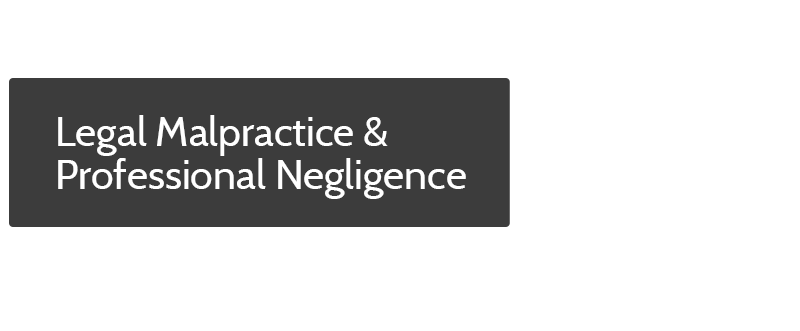Tolling the Statute of Limitations on Malpractice
WHEN DOES A CLIENT “DISCOVER” LEGAL MALPRACTICE FOR PURPOSES OF THE STATUTE OF LIMITATIONS?
A client has “discovered” an attorney’s malpractice for statute of limitations purposes when the client knows or should have known about the lawyer’s wrongful act or omission. The client does not have to realize that the wrongful act constitutes “negligence” or “malpractice” in order for the statute of limitations to begin to run. Note that the trigger is knowledge (or imputed knowledge) of the attorney’s wrongful conduct — the act which constitutes malpractice — even if the client does not label the action “malpractice” on his or her own.
For this reason, it’s critical to obtain an independent consultation and review of your legal rights and potential claims by an experienced attorney as soon as you know or suspect that your attorney may have done something wrong. Don’t wait . . . delay may negatively impact your legal rights.
THE STATUTE OF LIMITATIONS ON MALPRACTICE DOES NOT RUN UNTIL THE CLIENT SUFFERS INJURY
Normally, a client has already suffered damages by the time (s)he discovers that a lawyer has engaged in negligent representation or made an act or omission that constitutes malpractice. When this is true, the statute of limitations begins to run immediately (unless circumstances started it even before discovery, which is less common).
However, in unusual cases where the client discovers the negligence/malpractice before injury occurs, the statute of limitations may be tolled until the injury actually occurs. Even if the client discovers the lawyer’s malpractice before damage is sustained, the statute of limitations will not begin running until damage occurs. This is, in part, because “damages” are a mandatory element of a legal malpractice claim, so the plaintiff client cannot prevail on such a claim until damages are present.
WHAT KIND OF ACTUAL INJURY IS REQUIRED TO SUSTAIN A LEGAL MALPRACTICE CLAIM?
The injury sufficient to sustain a legal malpractice claim must be legally recognizable as damages in a legal malpractice action, and must involve more than nominal or speculative damage, or the threat of future harm. That may seem like a fuzzy test, but damages in legal malpractice actions are measured by a “facts and circumstances” test, which requires an evaluation of the specific facts of the client’s case to evaluate whether (or not) the lawyer’s wrongful action resulted in the client suffering damages.
***
Disclaimer: THIS ARTICLE IS FOR INFORMATIONAL PURPOSES ONLY, AND DOES NOT CONSTITUTE LEGAL ADVICE OR CREATE AN ATTORNEY-CLIENT RELATIONSHIP BETWEEN THE AUTHOR AND ANY PERSON. Your rights and experiences may vary. Never use an online article (including this one) to evaluate your legal claims. Speak with an experienced lawyer promptly to obtain a personalized evaluation of your claims, possible damages, and options. You may lose or compromise your rights if you delay in consulting legal counsel. Legal claims against lawyers or other third parties are a complicated topic. If you believe you have a claim against an attorney who failed to provide you with competent representation, or any other type of legal claim, consult an experienced lawyer immediately for an evaluation of your possible rights and claims.














